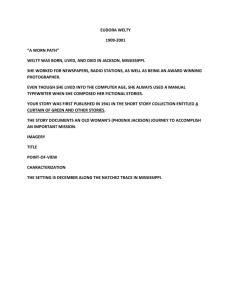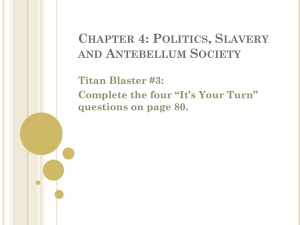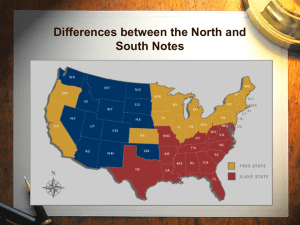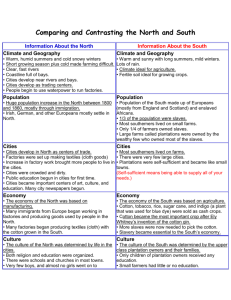Mississippi Politics, Slavery & Antebellum Society
advertisement
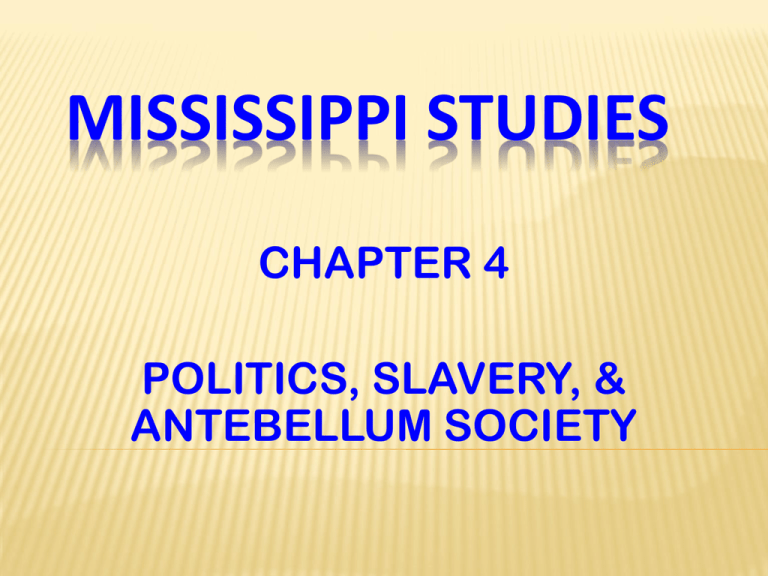
MISSISSIPPI STUDIES CHAPTER 4 POLITICS, SLAVERY, & ANTEBELLUM SOCIETY POLITICS Politics plays an important role in history. It makes people take sides, causes divisions within society, and also raises the issues that concerns people. One of the first issues to reveal the social divisions in antebellum Mississippi was the location of the capital. Antebellum – before the war THE STATE CAPITAL 1798 – Natchez was the capital because it was already a substantial frontier settlement on the MS River. 1802 – Washington became the capital when political rivalry led to relocating the capital away from Natchez. 1821 – LeFleur’s Bluff became the capital when it was decided that Washington was too small and the capital should be in the middle of the state. LeFleur’s Bluff – site along the Pearl River where Louis LeFleur traded with the Choctaw; later became Jackson Jackson – named in honor of Andrew Jackson, hero of the Battle of New Orleans Jackson remained a small town until the 1840s, when streets, houses, buildings, a Captiol, and a Governor’s Mansion were built. THE CONSTITUTION OF 1832 Many political changes came about in the early nineteenth century, including the issue of property ownership being a requirement to vote. This period of history is known as “The Era of the Common Man.” It was sparked by the election of Andrew Jackson as President in 1828. The Mississippi Constitution of 1832 reflected the idea of Jacksonian democracy. Changes to the constitution included: Judges were elected instead of being appointed Representation in both houses of legislature was determined only by population Banning the importation of slaves if they were to be sold (never applied) LOCAL GOVERMENT Although the state government was important, the county government met most of the needs of the citizens. After 1832, an elected Board of Police governed each county. Board of Police – group elected to govern each county The Board of Police had such duties as: Levying taxes, ordering the construction of courthouses and jails, appointing supervisors to build and maintain roads and bridges ACQUISITION OF NATIVE AMERICAN LAND Rapid growth throughout the state was aided by the removal of Native Americans. Through the they of assimilation, Native Americans began to see their property being taken away more and more throughout the state. Assimilation – theory that Native Americans relied on farming rather than hunting and they would require less land and could coexist with the settlers By the War of 1812, the government had given up on the policy of assimilation because they feared the Indians would side with the British or Spanish. The Creek and Shawnee Indians led by Tecumseh tried to unite the various tribes tin the area to resist white settlers; when Tecumseh was killed the resistance efforts ended. The Choctaw chief Pushmataha convinced his people not to join the efforts and kept peaceful relations with the settlers. FEDERAL TREATIES WITH NATIVE AMERICANS By 1783, only the Choctaw and Chickasaw Indian tribes remained in MS. In 1798, the MS Territory was established and treaties were negotiated with the Indian tribes to extend the range of the territory. Between 1801 and 1832, the federal government and the Indian tribes negotiated treaties that would cede nearly all of the Indian owned land of present day Mississippi to the United States. Cede – to give away 1801 – TREATY OF FORT ADAMS The US received almost 3 million acres of Choctaw land. The US also gained the right to build the Natchez Trace through Choctaw Territory. In return, the Choctaw would receive several thousand dollars worth of merchandise. Also, the Choctaw received a broken promise that nonNative Americans would be removed from Indian lands. 1805 – TREATY OF MOUNT DEXTER The US received over four million acres of land in south Mississippi. In return, Native American debts to traders and settlers were cancelled. Also, the Native American leaders like Pushmataha were given annual pensions. 1820 – TREATY OF DOAK’S STAND The US received five million acres of land, including present-day Jackson. In return, the Indians were promised lands west of the MS River, which they did not want to settle. 1830 – TREATY OF DANCING RABBIT CREEK The US received the remaining 10 million acres of Choctaw land. Also, the Choctaws promised to move to present day Oklahoma. The Choctaws were allowed to stay if they registered with the federal government. 1832 – TREATY OF PONTOTOC CREEK The US received the land in north Mississippi from the Chickasaw Indians. The Chickasaw Indians agreed to move to Oklahoma. TRAIL OF TEARS After ceding all of their land to the US government, the Native Americans began their trek to the Indian Territory, or present day Oklahoma. Along their journey, a great number of Indians died; this time of great suffering for the Choctaw, Chickasaw, Creek, Cherokee, and Seminole Indians became known as the Trail of Tears. SLAVERY IN MISSISSIPPI After forcing the Native Americans off of the lands of Mississippi, slaves were brought to America to work the land. By the 1720s, there were enough slaves in Louisiana (included MS) to require legislation, which came in the form of the Black Codes. These laws were issued by Governor Bienville in 1724. BLACK CODES The Black Codes, which only applied to blacks, were laws to govern all aspects of slavery and society, while granting slaves only a few rights. These codes covered: Under the Black Codes, slaves did have some protections: Marriage of slaves, ownership of property, travel, gathering in groups, and resistance to white owners Husbands and wives could not be separated; children under 14 could not be separated from their parents; owners could not mistreat their slaves; owners could not free the slaves to leave them helpless to die Under the Black Codes, freed slaves had all the privileges of free citizens. SLAVE LABOR & COTTON PRODUCTION The main occupations of slaves included agriculture and the production of lumber. Main crops grown by the slaves included: indigo, tobacco, and cotton. In 1793, Eli Whitney invented the cotton gin, which revolutionized the process of harvesting cotton. The first cotton gin in Mississippi was designed and built by a slave from the Natchez District named Barclay. With the cotton gin, long growing seasons, very fertile soil, and many navigable rivers, cotton production in MS reached an all-time high. People began to refer to it as “King Cotton.” Large plantations were built to produce cotton a commercial scale, while some families grew and produced cotton on smaller scales. COTTON GIN PLANTATION LIFE IN ANTEBELLUM MISSISSIPPI WORKING & LIVING CONDITIONS OF SLAVES Slave worked all types of jobs, but mainly jobs dealing with the production of cotton; other jobs included: cooking, cleaning, tending the livestock, making clothes, and caring for children. Skilled slaves often worked as carpenters, blacksmiths, and brick masons. The slave owner usually supervised the slaves; however, if the owner did not live on the farm or plantation, an overseer was hired. A driver often supervised the world of small groups of slaves. Owners enforced discipline and work rules; some offered incentives like extra clothing, money, time off, or tools for hard work. THE SLAVE COMMUNITY & RESISTANCE After Mississippi became part of the United States, the Black Codes no longer existed and slaves were considered property and had no rights and many restrictions. Due to this, the slaves were unable to develop stable communities; however, they adopted Christianity and saw it as a pathway to freedom in this life and the next. Many slaves participated in revolts and resistance attempts which included: running away, poisoning their owners, breaking machinery, burning equipment and goods, and slowing down the work pace. FREE BLACKS Some blacks were free in Mississippi, but they lived under many restrictions. Most of these slaves lived in towns like Natchez and Vicksburg and worked many types of jobs. One of the most prominent slaves in MS was William Johnson. He was a barber in Natchez who owned town lots, a farm, and slaves. He was murdered, but his alleged killer was never brought to justice because blacks could not testify in court. ANTEBELLUM SOCIETY With the removal of the Indians, MS experienced a land boom and population explosion. The price of land was cheap and the price of cotton was high. Due to this, banks extended easy credit and issued paper money far in excess of the specie in their vaults; however, this would lead to problems for MS. At the same time, Andrew Jackson, who was heavily supported throughout MS, was elected President. His use of pet banks would cause huge economic problems in the state. One such bank was the Planters Bank of Natchez. ECONOMIC PROBLEMS The problems caused by the Jacksonian economics were soon corrected by the federal government. In 1836, Specie Circular was issued. This required that government land be paid for with specie rather than useless paper money. At the same time, the Distribution Act was issued. This required the money in the federal treasury be paid to the states in specie. When the banks could not provide the gold and silver, they collapsed. In 1837, the Planter’s Bank failed. PANIC OF 1837 When the Planter’s Bank failed in 1837, an economic depression occurred. This depression would last until 1841. Mississippi was hit hard by the depression. The federal government foreclosed on land bought on credit. Also, bonds issued by the state were declared invalid. These bonds remain unpaid to this day. TRANSPORTATION - WATERWAYS Steamboats were a major form of transportation as they carried cotton and other goods on the Mississippi, Yazoo, Big Black, Pearl, and Tombigbee Rivers. Most of the cotton was shipped to New Orleans and Mobile, where it was sent to the textile mills of New England or Great Britain. TRANSPORTATION - RAILROADS Railroads began to spring up in Mississippi. In stage one, the railroads were built to transport the cotton from the farms to the river ports. The Vicksburg and Jackson Railroad was the most successful in the state. Later, the line was extended to reach Meridian. In stage two, small railroads were combined into trunk lines, joining other cities in the nation. The New Orleans, Jackson, and Great Northern Railroads connected New Orleans and Jackson. The Mississippi Central Railroad linked Jackson and Memphis. The Memphis and Charleston Railroad linked Tennessee to the Atlantic Coast EDUCATION Public education developed slowly because most counties could not afford to spend much money. In places where schools were located, only the basics of reading, writing, and arithmetic were taught. There were not schools for blacks. Higher education was usually the responsibility of religious or private organizations. Jefferson College in Washington became the first institute of higher education in MS. In 1840, the University of MS was established, but did not begin operations until 1848. RELIGION In Mississippi, most people, including blacks and whites were considered religious people. Many Christian denominations established churches in MS, including: Presbyterians, Episcopalians, and Catholics. The largest groups were the Methodists and the Baptists. SECTION 1 QUESTIONS – PG 80 1. Why was the state capital moved to Jackson? 2. What provisions of the Constitution of 1832 showed the impact of Jacksonian democracy? 3. What powers did the county board of police have? SECTION 2 QUESTIONS – PG 85 1. Was the federal government of the state government responsible for relations with the Native Americans? 2. Name the five treaties by which the Choctaw and Chickasaw ceded their Mississippi land to the federal government. 3. Why was the removal of Native Americans westward called the Trail of Tears? SECTION 3 QUESTIONS – PG 92 1. What were some of the important provisions of the Black Code issued by the French in 1724? 2. What types of jobs did slaves do on farms and plantations? 3. Who was the most prominent free black in antebellum Mississippi? SECTION 4 QUESTIONS – PG 98 1. In which decade did the population of MS increase the most rapidly? 2. What was the importance of Specie Circular? 3. How did railroads both help and hurt the economy of Vicksburg? 4. What were the two largest religious denominations in MS in the antebellum period?

